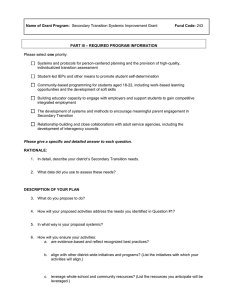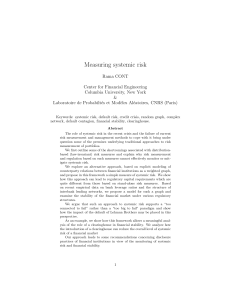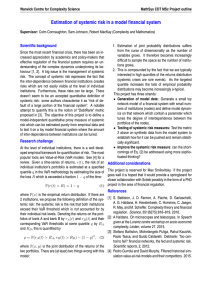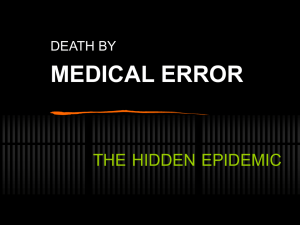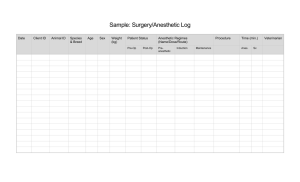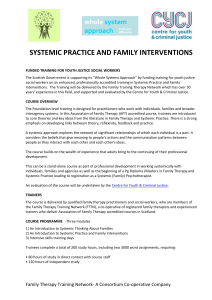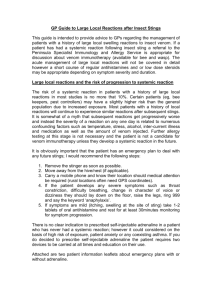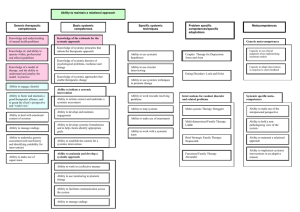20140925153017001-215077 - Isaac Newton Institute for
advertisement
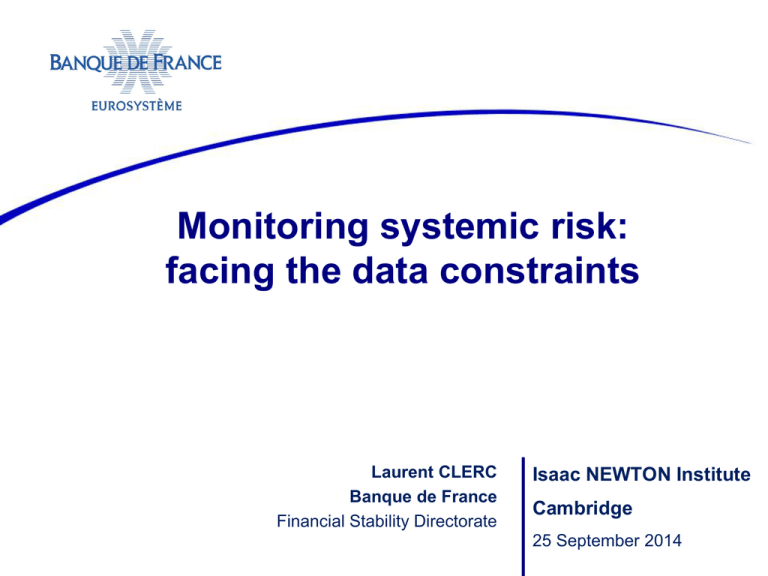
Monitoring systemic risk: facing the data constraints Laurent CLERC Banque de France Financial Stability Directorate Isaac NEWTON Institute Cambridge 25 September 2014 An amazing amount of research on systemic risk measures… but mostly based on market price data • Financial Indicators on Risk and Stability (FIRST), by Avesani (2005) • Expected number of defaults (END), by Chan-Lau and Gravelle (2005) • Conditional Value-at-Risk (CoVaR), by Adrian and Brunnermeier (2008) • Conditional probability of failure of a large fraction of financial institutions, by Giesecke and Kim (2009) • Banking Stability Measures (in particular BSI and JPoD), by Segoviano and Goodhart (2009) • Distress insurance premium (DIP) of the banking system and an institution’s marginal contribution to it, by Huang et al. (2009) and Huang et al. (2010) • Marginal expected shortfall (MES), by Acharya et al. (2010) and disentangled into volatility, correlation and tail risk by Brownlees and Engle (2010) • Measure institutions’ systemic importance using Shapley value methodology, by Tarashev et al. (2010) and Drehmann and Tsatsaronis (2011) • Information contained in central bank communication to help measure stress in financial markets (specific focus on the euro area), by Grimaldi (2010) • Composite Indicator of Systemic Stress (CISS) (specific focus on the euro area), by Hollo et al. (2010) • Systemic risk diagnostics (simultaneous failure of a large number of bank and non-bank intermediaries), by Schwaab et al. (2010) • Bank Vulnerability (AV), by Greenwood et al. (2011) • Contigent Claim Analysis (CCA), by Gray and Jobst (2011) • Non-Core liabilities ratio (Hahm et al., 2011) • Contagion Index, Cont et al. (2012) • Granger causality on principal components, by Billio et al. (2012) • A Survey of Systemic Risk Analytics (31 measures), by Bisias et al. (2012) •SRISK (Brownlees and Engle, 2011 ; Acharya et al. AER, 2012) • Multi-CoVaR and Shapley value, by Cao (2013) • Domino Effects when Banks Hoard Liquidity, Fourel et al. (2013) • A Network View on Money Market Freezes, Abassi et al. (2013) • Evaluating Early-Warning indicators of banking crises, Drehmann and Juselius (2013) • Macro-financial vulnerabilities and future financial stress, Lo Duca and Peltonen (2013) 2 Market price and exposures data: Does it make any difference? Table 10: Correlations between market-price and exposure-based measures (06 Jan 2012) Contr-CoVaR Exp-CoVaR Contr-CoCDS Exp-CoCDS CDS-val MES-val Rel. Cap.shortfall Market-val (08 Jan 2010) Contr-CoVaR Exp-CoVaR Contr-CoCDS Exp-CoCDS CDS-val MES-val Rel. Cap.shortfall Market-val Eigenvector 0.542 0.031 0.043 -0.184 -0.237 0.138 0.639 Betweenness 0.545 -0.069 -0.277 -0.247 -0.312 -0.089 0.583 Exposure 0.688 0.106 0.048 -0.214 -0.204 0.251 0.712 Indegree 0.635 -0.013 -0.300 -0.305 -0.330 -0.013 0.643 0.107 Eigenvector 0.118 0.174 0.012 -0.060 -0.233 0.130 0.579 0.266 Betweenness -0.086 -0.088 -0.412 -0.344 -0.220 0.070 0.216 0.202 Exposure 0.105 0.093 -0.138 -0.200 -0.269 0.076 0.704 0.220 Indegree 0.016 0.030 -0.294 -0.243 -0.266 0.086 0.623 0.245 0.273 0.371 0.369 Source: Clerc, Gabrieli, Kern & el Omari (2014): Monitoring the European CDS Market through Networks: Implications for Contagion Risks, Banque de France Working Paper, n° 477, March. 3 Regulatory efforts to overcome the data issue and better monitor systemic risk Before the crisis: data driven process Available data set (public data) Research Policy Since 2009: policy driven process: e.g. the G20 Data Gap initiative Policy Data gaps ? Research 4 The data Gap initiative • Development of measures of system-wide, macroprudential risk • Development of a common data template for GSIFIs • Enhancement of BIS consolidated banking statistics • Development of a standardized template covering the international exposure of large non bank financial institutions • 10 countries participating in the Hub (located at the BIS) • The access of Central banks to the Hub is recent (10 days ago): 10 members ; BIS provide reports 5 ODRF guidelines for authorities access to TR data 6 ODRF guidelines for authorities access to TR data 7 ODRF guidelines for authorities access to TR data 8 Current challenges: is the information sufficient for systemic risk monitoring? • Multilateral surveillance vs. nationally oriented supervision • No supervisory authority has the global picture • But efforts to develop resolution regimes for GSIFIs • Limited information: so far, no information on collateral (the collection of information has just started this year); difficult also to get consistent exposures across various classes of derivatives 9 New Challenges: the Data Tsunami • Post Crisis regulatory environment • Ex. EMIR in Europe o o o o 6 Trade repositories registered by the ESMA Billions of daily observations Still limited information on collateral Issue of the consistency of the information gathered by the TR, the extent to which data can be aggregated… o Cost of storage: ex. DTCC invested USD100 millions to develop its information system 10
